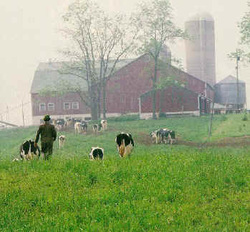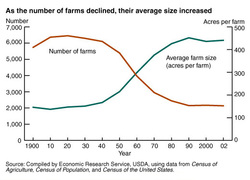Family Farming in America
"I had rather be on my farm than be emperor of the world"
- George Washington
WHAT IS FAMILY FARMING AND ASSOCIATED PROBLEMS

America was built upon agriculture. From the founding of the nation, in which we adapted methods used by the Native Americans, to the present day in which the United States ranks as the world's largest agricultural exporter, farming continues to serve as the backbone of American society. A practice continued throughout the nation's history is family farming. The oldest form of managing crops, a family farm is a farm owned by a family, whose operation is passed down to future generations. The family farm is typically viewed as its own culture and is beneficial to the preservation of the American land.
Statistically, the family farm makes up ninety-eight percent of all American farms, while farmers in general comprise 2% of the work force in the United States. 40% of the crop market is accounted for by 2.5% of nation's total farms, while family farmers produce approximately twenty-seven percent of the American crop production.
Family farms are valued by communities in that they are viewed as a "cleaner quality of life." Other than increasing family unity, promoting good morals and decreasing crime rates, these farms provide job opportunities. In rural communities a local market is greatly relied upon as a food source. The family farmer mentality is that individual farms should be the focus, rather than the farming industry as a whole.
However, family farming is a rapidly decreasing trade. While over half of family farms have an off-farm income, the private domestic product fell from 35% to 5.8%, with a GNP rising to 40 fold. There are seven hundred and fifty thousand less family farms since 1981, an equivalent to 1 million jobs lost. While the number of family farms decreases, acreage increases. In over 70 years, 7 million farms have become 2 million, causing the rate of self employment in agriculture to decrease as well.
What is the cause of these trends? One answer is taxes. With a lack of access to markets, the benefits from farm programs go to larger farms. Family farmers are also unable to attract new investors. With a high cost of equiptment (averaging an intial cost of about $200,000) and an inflation in the price of land, investors are necessary. However, the average age for famers has risen to 58 years old, with only 6% of the farmers being under the age of 35. What investors look for in businesses is the probability that their investments will succeed or not. Failure is viewed as more common in older people, especially in a line of work that requires intense physical labor, such as farming. Though farmers do recieve consumer dollars for the food they produce, their income is often offset by inflation. In 1980, a farmer recieved $.37 for every consumer dollar spent on food, a net income equivalent to that of the Great Depression. While today, the farmer recieves $.20.
The new generation sells off the family farm and migrates from the rural country to the city. As these farms are shut down, they are not replaced by new farms and young farmers. Though farming is highly romanticized throughout history as a traditional culture that represents old America, the ideal is not necessarily accurate. Family farms today are struggling to survive.

